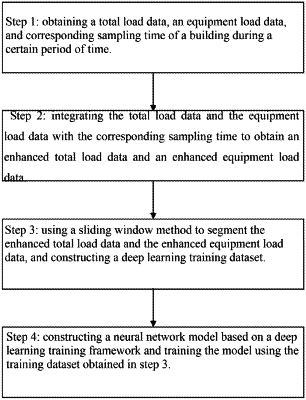| CPC G06N 3/049 (2013.01) | 6 Claims |

|
1. A non-intrusive load monitoring method based on temporal attention mechanism, comprising the following steps:
step 1: obtaining a total load data, an equipment load data, and corresponding sampling time of a building during a certain period of time;
step 2: integrating the total load data and the equipment load data with the corresponding sampling time to obtain an enhanced total load data and an enhanced equipment load data;
step 3: using a sliding window method to segment the enhanced total load data and the enhanced equipment load data, and constructing a deep learning training dataset;
step 4: constructing a neural network model based on a deep learning training framework and training the model using the training dataset obtained in step 3;
wherein, the step 1 is specially as follows:
obtaining a load power consumption of the building during a certain period of time, sampling time T=[t0, t1, . . . , tn], and the total load data comprises a total load active power Pt0:tn, a reactive power Qt0:tn, and an apparent power St0:tn, the equipment load data comprises an active power Pt0:tni, a reactive power Qt0:tni; and an apparent power St0:tni of each equipment during the above sampling time, where i is the equipment number;
wherein, the step 2 is specially as follows:
firstly, converting the sampling time T=[t0, t1, . . . , tn] to the corresponding number of weeks, that is Td=[d0, d1, . . . , dn], wherein, dn represents the number of weeks the sampling time tn belongs to;
then, based on the attention mechanism, the total load data and the equipment load data are fused separately with Td, as shown below:
F=attn(F,Td)
among them, F can represent the total load active power Pt0:tn, the reactive power Qt0:tn and the apparent power St0:tn, as well as the equipment load active power Pt0:tni, the reactive power Qt0:tni and the apparent power St0:tni; F represents the load data after fusion and enhancement with time information Td; obtaining the enhanced total load data Pt0:tn, Qt0:tn and St0:tn, and the enhanced equipment load data Pt0:tni, Qt0:tni and St0:tni; attn( ) represents the attention mechanism function; and
wherein, after the model training is completed, it is applied to load monitoring in other time periods, specifically, the method described in step 2 is used to enhance the active, reactive, and apparent power data of the building for any length of time period w, the trained neural network model is input, and the model output is the equipment's power consumption in the building during this time period.
|